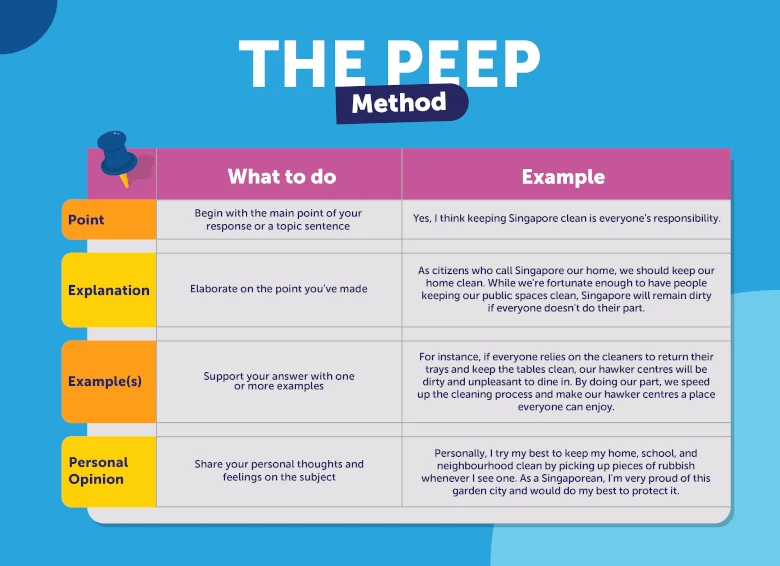A complete guide to PSLE stimulus-based conversation
- Tags:
- Primary English

In the competitive world of PSLE English examination, the Stimulus-Based Conversation (SBC) is a crucial component that can make or break your child's performance. In this comprehensive guide, we will delve into the intricacies of the PSLE English Oral Stimulus-Based Conversation, providing you with invaluable insights and strategies to help your Primary 6 student excel in this challenging assessment.
Understanding PSLE English oral stimulus-based conversation
Stimulus-based conversation forms one-half of the PSLE English oral component, with the other half being the reading component. Our focus here, however, is squarely on the PSLE English oral stimulus-based conversation.
What to Expect in PSLE English oral stimulus-based conversation
In this section of the English paper, your child will engage in a conversation with the examiner, guided by a picture known as the "stimulus." The examiner will begin with a direct question related to the stimulus, followed by broader inquiries related to the overarching theme depicted in the image.
Objectives of the English oral stimulus-based conversation
As per Singapore's Ministry of Education (MOE), which shapes the PSLE syllabi, the primary objectives of this examination are as follows:
- Oral expression: Students should be able to express their ideas, feelings, and opinions verbally, with clarity and conciseness.
- Grammatical accuracy: Speaking with grammatical accuracy, using a wide range of vocabulary and sentence structures.
What are the questions to expect from stimulus-based conversation?
Dealing with directly-linked questions
The examination typically commences with a direct question based directly on the stimulus. Here's what you need to keep in mind:
- The first question is usually straightforward and linked to the stimulus.
- Your child should formulate their answers based on the picture that they have been shown.
- The initial direct question is often followed by a "Why" question.
Types of directly-linked questions
Directly-linked questions in the PSLE English stimulus-based conversation can be further categorised into two types:
- Choice-based questions
- If your child is shown:
- A character making a choice between two or more objects: they may be asked which option they prefer and why.
- An advertisement or a product: they may be asked if they would buy the product and why.
- An invitation or a brochure for an event: they may be asked if they will attend the event and why.
- If your child is shown:
- Function and purpose
- If your child is shown:
- A signage: they may be asked where are they most likely to come across such signage.
- Product descriptions: they may be asked questions like where is this product used, who will use this product, and how will they use the product.
- If your child is shown:
Tips for answering directly-linked questions in English stimulus-based conversation
Help your child understand that they need to:
- Enhance their response by sharing a personal anecdote, story, or news related to the picture.
- Conclude their response effectively and tie it back to the question.
- Carefully analyse the provided picture and text details before formulating their answers.
Key to success
The crux of acing the PSLE English oral stimulus-based conversation lies in your child's ability to express themselves fluently and effectively in English. This applies not only to answering direct questions but also to handling broader inquiries. To further enhance their performance, students can gain an edge by drawing parallels between the stimulus and other anecdotes, movies, or stories.
To help your child get ready for the stimulus-based conversation, you can support them in mastering these two answer structuring techniques:
1. The PEEP method
2. The TREE method
1. The PEEP Method
We covered the PEEP method in this article, but to recap, the PEEP method is Point, Explanation, Illustrations, and Personal Insights.
Sample Question:
Is it everyone's responsibility to contribute to maintaining cleanliness in Singapore?

2. The TREE method
| Thought |
Yes, it is everyone's responsibility to contribute to maintaining cleanliness in Singapore. |
| Reason |
The reason behind this is that cleanliness is crucial for the well-being of the community and the environment. When everyone takes responsibility for keeping Singapore clean, it creates a healthier and more pleasant place to live. |
| Example |
For example, when people dispose of their trash properly in bins and refrain from littering, it reduces the risk of pollution and the spread of diseases. Also, when individuals and businesses take steps to minimise waste and recycle, it helps conserve resources and reduce the strain on landfills. |
| Experience |
In my experience, Singaporeans take great pride in their clean and green city. Many participate in community clean-up activities, and there are strict regulations against littering and improper waste disposal. This collective effort has contributed to Singapore's reputation as one of the cleanest cities in the world. |
| Suggestion |
To maintain cleanliness in Singapore, I suggest that everyone continues to follow the rules and guidelines for waste disposal and recycling. Additionally, promoting awareness and education about the importance of cleanliness can further encourage responsible behaviour among residents and visitors alike. |
How to help my child come up with points to speak?
In conclusion, it's important to encourage your child to become familiar with the types of questions asked and to feel at ease with the formats of their answers. Happy learning!
 SG
SG  VN
VN 














